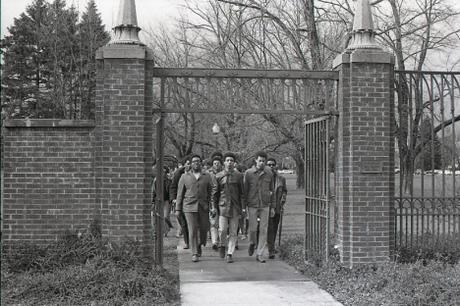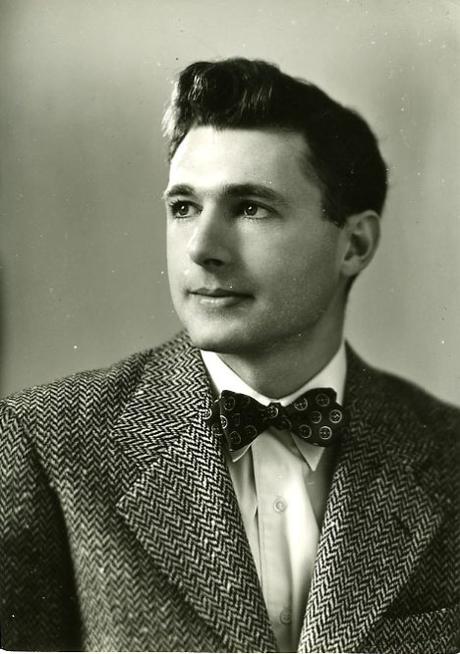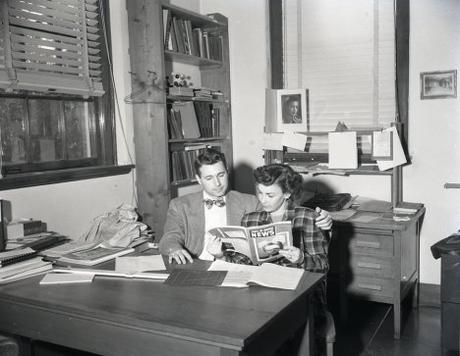
African American students leaving the OSU campus through its west gate, February 25, 1969.
[Ed Note: We recently received a collection of photographs documenting an important moment in the history of Oregon State University – a walkout of African American students led by OSU’s Black Student Union in winter 1969. While this is largely an OSU story, Linus Pauling did play a role in the event, which we’ll explore this week and next.]
The racial tensions that escalated throughout the 1960s and that made an imprint on universities all across the United States were evident on the campus of Oregon State University as well. In a description that accompanied a photo collection recently accessioned by the OSU Libraries Special Collections and Archives Research Center, photographer Gwil Evans, who was a Journalism professor at OSU at the time, provided some background on event that served as a pivot point for race relations at Oregon State near the end of the 1960s.
In his notes, Evans explained that, on February 25, 1969, members of the OSU Black Student Union interrupted a convocation hosted by President James Jensen at OSU’s Gill Coliseum. The convocation, which was part of a series of events marking the university’s centenary, was to feature a speech by Linus Pauling, Oregon State’s most prominent alum.
The immediate cause of the interruption and subsequent protest was a demand issued by OSU’s football coach, Dee Andros, that one of his players, and African American student athlete named Fred Milton, shave his facial hair. This conflict arose in the context of a longer history of racial tensions on campus, as well as concurrent protests related to tuition hikes and the escalation of the Vietnam War.
There was also an uneasiness associated with the talk itself, both with respect to Pauling’s presence on campus as well as the way in which he was introduced to the large crowd that assembled for his lecture. These issues dated back many years, stemming from a schism that had developed between Pauling and Oregon State in 1949, due to Pauling’s belief that Ralph Spitzer – a former graduate student of Pauling’s who was fired from his faculty position at Oregon State College – was let go due to his political beliefs.

Ralph Spitzer.
Pauling had known Spitzer since serving as a Visiting Lecturer at Spitzer’s undergraduate alma mater, Cornell University, in 1937. Spitzer then went on to complete his Ph.D at Caltech in 1941 under the general supervision of Pauling, and sometimes working directly for Pauling. The two shared a strong mutual respect and often closed their letters with questions asking after wives, children, and general well-being. Pauling ultimately helped Spitzer to secure research funding and a teaching position at Oregon State College by providing his pupil with a series of consistently glowing recommendations.
Once they had arrived in Corvallis, Spitzer and his wife Terry became increasingly interested in American social problems as well as a multitude of issues related to the atomic bomb. This concern in matters well beyond the teaching of chemistry, coupled with Ralph and Terry’s lack of hesitation in voicing their opinions, ultimately resulted in Spitzer’s firing by OSU President August Strand in February 1949.

Ralph and Terry Spitzer, April 1949.
A letter that Spitzer had published in Chemical and Engineering News supporting Trofim Lysenko’s evolutionary theory of vernalization and, more broadly, Soviet science, provided a useful excuse for the OSC administration to deny renewal of his contract. Although this was, on a technical level, an acceptable action for the president to take, since Spitzer was not tenured and he was not fired for explicitly political reasons, word of the incident quickly spread across campus and the region.
One of Spitzer’s immediate responses upon being informed of his impending dismissal was to write to Pauling seeking his help. He also asked for a trial before the American Chemical Society (ACS), which refused to become involved in the incident despite the fact that Pauling himself was president at the time.
Nonetheless, after studying the details of the situation, Pauling wrote to President Strand and informed him that, although he did not hold the same beliefs as Spitzer, he believed his former student was certainly entitled to harbor opinions of this sort, and that OSC needed to honor them as a matter of academic freedom and respect for the principles of democracy. Speaking as an OSC alumnus, fellow chemist, educator, American, and president of the ACS, Pauling urged Strand to reconsider his decision to fire Spitzer.
Strand responded to Pauling forcefully, writing that
if by this action, Oregon State College has lost your respect and support, all I can say is that your price is too high. We’ll have to get along without your aid.
And so it was that Pauling did not engage with his alma mater until December 1966, five years after Strand had retired from his post
Though the ice between Pauling and OSU had been broken a couple years prior, the situation remained awkward as he arrived on campus for the centenary lecture series. Of particular note, Strand’s successor as OSU President, James Jensen, elected not to introduce Pauling. Instead, Bert Christensen, who was chair of the OSU Chemistry department, was asked to fill this role. This decision was far from customary for a visitor of Pauling’s magnitude and was viewed by many as an affront.
Pauling himself made note of being surprised upon learning of this breach in normal protocol. He was far more surprised when Christiansen’s introduction was abruptly interrupted by the president of the Black Student Union, the details of which we’ll explore next week.
